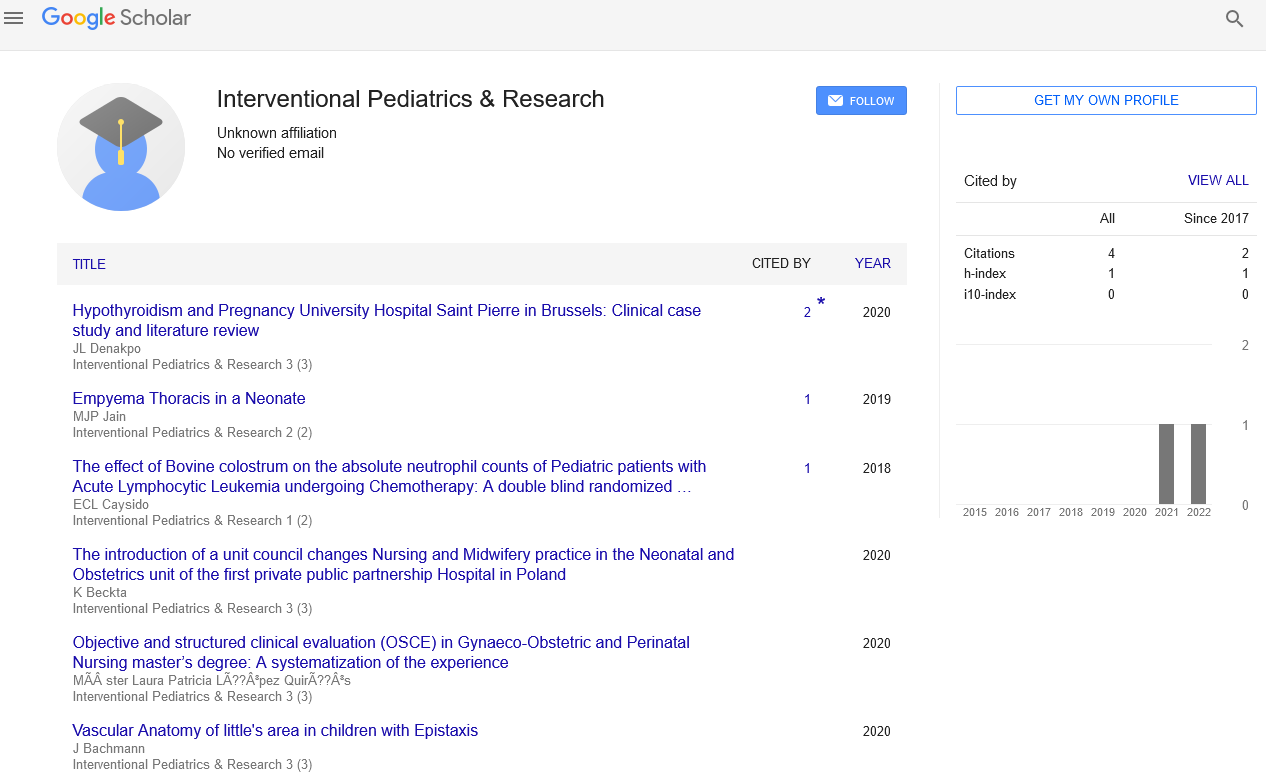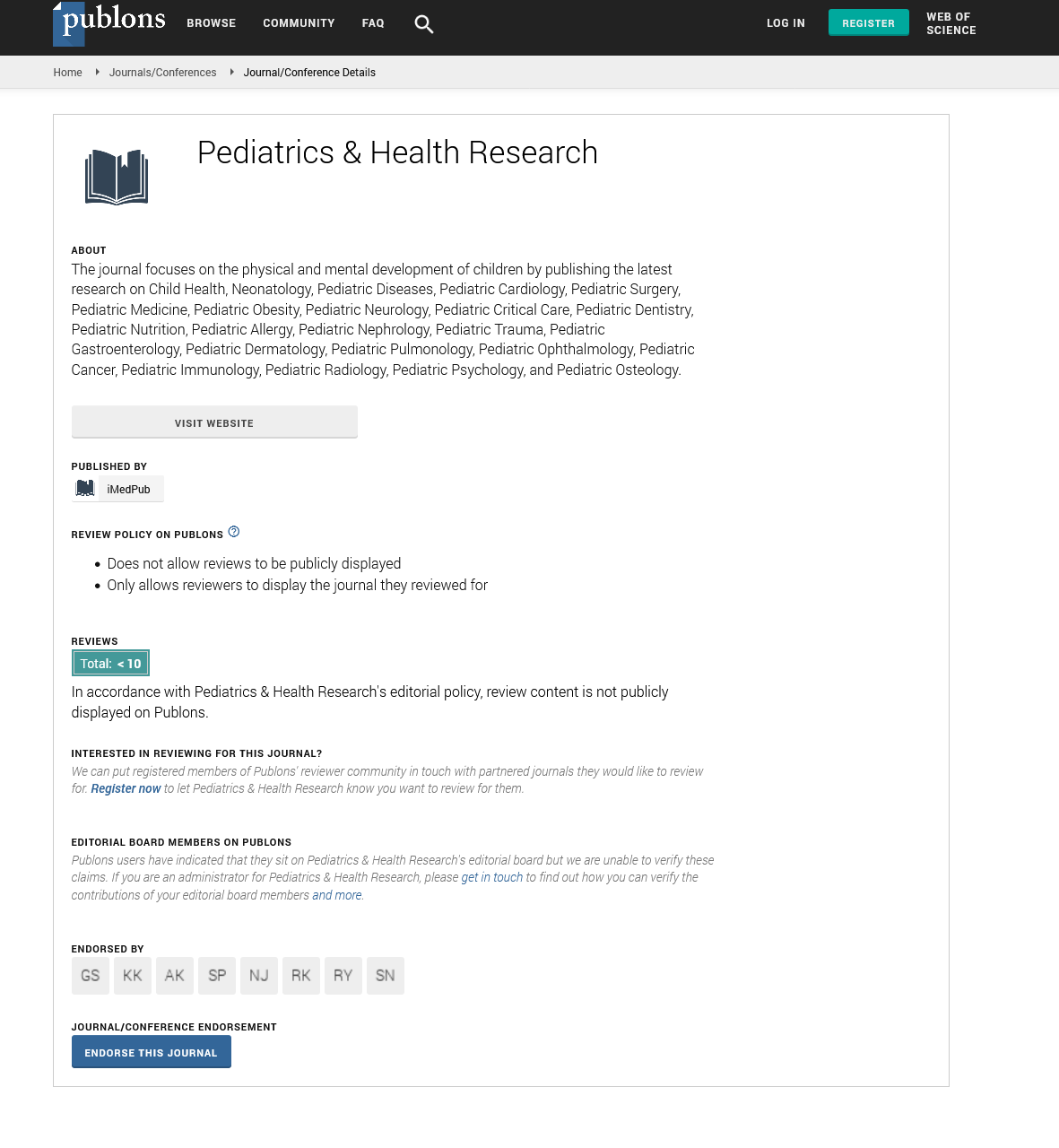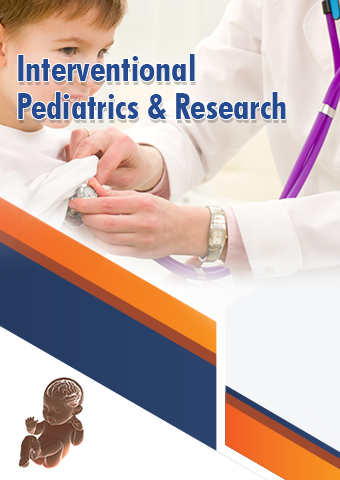Case Report - Interventional Pediatrics & Research (2023) Volume 6, Issue 2
Pediatric Pulmonology Interventions Improving Respiratory Health in Children
Anthony Joseph*
Department of Pediatrics & Research, Brazil
Department of Pediatrics & Research, Brazil
E-mail: joseph_an77@gmail.com
Received: 01-April-2023, Manuscript No. ipdr-23-96781; Editor assigned: 03-April-2023, Pre-QC No. ipdr-23- 96781 (PQ); Reviewed: 18-April-2023, QC No. ipdr-23-96781; Revised: 24-April-2023, Manuscript No. ipdr-23-96781 (R); Published: 28-April-2023, DOI: 10.37532/ ipdr.2023.6(2).37-39
Abstract
Pediatric cardiology interventions are medical procedures used to diagnose and treat heart conditions in children. These interventions are crucial for managing congenital heart defects, arrhythmias, and acquired heart diseases. Surgical interventions, such as openheart surgery and minimally invasive techniques, are commonly used to manage heart defects. Non-invasive interventions, such as medications and lifestyle changes, may also be recommended. For arrhythmias, catheter ablation is a common intervention that has a high success rate and is considered safe for children. With early diagnosis and appropriate treatment, many children with heart conditions can go on to live healthy, active lives.
Keywords
Pediatric pulmonology • Interventions • Respiratory health • Children • Asthma • Bronchitis • Cystic Fibrosis • Pulmonary function tests • Inhalation therapy.
Introduction
Pediatric pulmonology is a specialized branch of medicine that focuses on the diagnosis, treatment, and management of respiratory disorders in children [1]. The field is concerned with both acute and chronic respiratory conditions, such as asthma, bronchitis, cystic fibrosis, and pneumonia, among others. Pediatric pulmonology interventions play a critical role in improving the quality of life of children with respiratory disorders, and in some cases, they can be lifesaving. Pediatric pulmonologists are specialists who are trained to manage respiratory disorders in children [2]. They work closely with other healthcare professionals, such as respiratory therapists, nurses, and nutritionists, to develop comprehensive treatment plans tailored to each patient’s needs. The goal of pediatric pulmonology interventions is to improve lung function, reduce symptoms, and prevent complications associated with respiratory disorders. One of the most common pediatric respiratory conditions is asthma. It affects approximately 1 in 12 children in the United States and is a leading cause of hospitalizations and emergency room visits. Pediatric pulmonology interventions for asthma may include the use of inhaled medications, such as bronchodilators and corticosteroids, to reduce inflammation and open airways. Pulmonary function tests may also be used to evaluate lung function and monitor the effectiveness of treatment [3]. Cystic fibrosis is another common pediatric respiratory disorder that requires specialized care. It is a genetic condition that affects the lungs and digestive system and can lead to serious complications, such as lung infections, respiratory failure, and malnutrition. Pediatric pulmonology interventions for cystic fibrosis may include the use of airway clearance techniques, such as chest physiotherapy and nebulized medications, to help clear mucus from the lungs. Antibiotics may also be prescribed to treat infections, and nutritional support may be provided to prevent malnutrition [4]. Pediatric pulmonology interventions may also be required for children with chronic lung diseases, such as bronchopulmonary dysplasia (BPD) and interstitial lung disease (ILD). BPD is a condition that affects premature infants who require mechanical ventilation and oxygen therapy, while ILD is a group of conditions that cause inflammation and scarring of the lung tissue. Pediatric pulmonology interventions for these conditions may include the use of oxygen therapy, medications, and pulmonary rehabilitation programs to improve lung function and reduce symptoms [5]. In addition to medical interventions, pediatric pulmonologists may also provide education and support to families of children with respiratory disorders. This may include information on how to manage symptoms at home, how to recognize signs of worsening symptoms, and how to prevent complications. Pulmonary rehabilitation programs may also be offered to help children and their families cope with the emotional and physical challenges of living with a respiratory disorder [6]. Pediatric pulmonology interventions play a crucial role in the diagnosis, treatment, and management of respiratory disorders in children. These interventions aim to improve lung function, reduce symptoms, and prevent complications associated with respiratory conditions. Pediatric pulmonologists work closely with other healthcare professionals to develop comprehensive treatment plans tailored to each patient’s needs, and they provide education and support to families to help them manage the condition at home [7]. With proper care and management, children with respiratory disorders can lead healthy, active lives.
Advantages
Improved Respiratory Health: Pediatric pulmonology interventions can significantly improve respiratory health in children suffering from conditions such as asthma, bronchitis, cystic fibrosis, and other respiratory diseases [8].
Better Quality of Life: By improving respiratory health, children can enjoy a better quality of life, including better sleep, increased activity levels, and fewer missed school days.
Early Detection and Treatment: Pediatric pulmonologists can detect respiratory issues early, allowing for timely intervention and treatment, which can prevent the progression of respiratory diseases [9].
Personalized Treatment: Pediatric pulmonologists can develop personalized treatment plans for children, taking into account their unique needs and medical history.
Access to Advanced Technology: Pediatric pulmonology interventions often involve the use of advanced technology, such as pulmonary function tests and inhalation therapy, which can help diagnose and treat respiratory issues more effectively.
Disadvantages
Cost: Pediatric pulmonology interventions can be expensive, especially for families without insurance coverage or limited financial resources.
Risk of Complications: Some interventions, such as inhalation therapy or airway clearance techniques, carry the risk of complications, including bronchospasm, coughing, or chest discomfort.
Time-Consuming: Pediatric pulmonologyd interventions, such as exercise therapy, airway clearance techniques, and respiratory education, can be time-consuming, requiring a significant commitment from both the child and their family.
Dependence on Medications: Some interventions, such as inhalation therapy, may require long-term medication use, which can result in dependence or adverse side effects.
Emotional Impact: Living with a respiratory disease can be emotionally challenging for children and their families, and pediatric pulmonology interventions may add to this burden, including frequent medical appointments and treatments.
Conclusion
Pediatric pulmonology interventions can significantly improve respiratory health in children and provide a better quality of life. Early detection and personalized treatment plans can prevent the progression of respiratory diseases and allow for timely intervention [10]. While some interventions may be costly, timeconsuming, and carry a risk of complications, the benefits of improved respiratory health outweigh the disadvantages. It is crucial for healthcare professionals to prioritize early detection, diagnosis, and treatment of respiratory diseases in children to improve their overall health and well-being.
References
- Savoji H, Mohammadi MH, Rafatian N et al. Cardiovascular disease models: a game changing paradigm in drug discovery and screening. Biomaterials. 198, 3–26 (2019).
- Mensah GA, Roth GA, Fuster V. The global burden of cardiovascular diseases and risk factors: 2020 and beyond. J Am Coll Cardiol. 74, 2529–2532 (2019).
- Fernandez-Marmiesse A, Gouveia S, Couce ML. NGS technologies as a turning point in rare disease research, diagnosis and treatment. Curr Med Chem. 25, 404–432 (2018).
- Hood L, Tian Q. Systems approaches to biology and disease enable translational systems medicine. Genomics Proteomics Bioinformatics. 10, 181–185 (2012).
- Lippi M, Stadiotti I, Pompilio G et al. Human cell modeling for cardiovascular diseases. Int J Mol Sci. 21, 6388 (2020).
- Schuchardt M, Siegel NV, Babic M et al. A novel long-term ex vivo model for studying vascular calcification pathogenesis: the rat isolated-perfused aorta. J Vasc Res. 57, 46–52 (2020).
- Burger D, Touyz RM. Cellular biomarkers of endothelial health: micro particles, endothelial progenitor cells, and circulating endothelial cells. J Am Soc Hypertens. 6, 85–99 (2012).
- Farinacci M, Krahn T, Dinh W. Circulating endothelial cells as biomarker for cardiovascular diseases. Res pract thromb haemost. 3, 49–58 (2019).
- Harper RL, Maiolo S, Ward RJ et al. BMPR2-expressing bone marrow-derived endothelial-like progenitor cells alleviate pulmonary arterial hypertension in vivo. Respirology. 24, 1095–1103 (2019).
- Sen S, McDonald SP, Coates TP. Endothelial progenitor cells: novel biomarker and promising cell therapy for cardiovascular disease. Clin Science. 120, 263–283 (2011).
Indexed at, Google Scholar, Crossref
Indexed at, Google Scholar, Crossref
Indexed at, Google Scholar, Crossref
Indexed at, Google Scholar, Crossref
Indexed at, Google Scholar, Crossref
Indexed at, Google Scholar, Crossref
Indexed at, Google Scholar, Crossref
Indexed at, Google Scholar, Crossref
Indexed at, Google Scholar, Crossref


